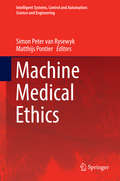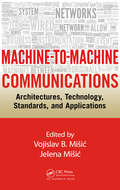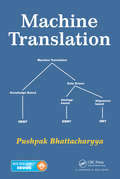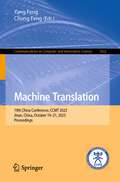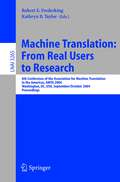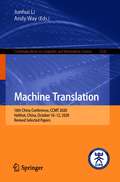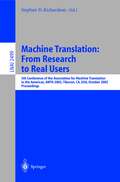- Table View
- List View
Machine Learning with scikit-learn Quick Start Guide: Classification, Regression, And Clustering Techniques In Python
by Kevin JollyScikit-learn is a robust machine learning library for the Python programming language. It provides a set of supervised and unsupervised learning algorithms. This book is the easiest way to learn how to deploy, optimize and evaluate all the important machine learning algorithms that scikit-learn provides.
Machine Learning with Spark
by Nick PentreathIf you are a Scala, Java, or Python developer with an interest in machine learning and data analysis and are eager to learn how to apply common machine learning techniques at scale using the Spark framework, this is the book for you. While it may be useful to have a basic understanding of Spark, no previous experience is required.
Machine Learning with Spark and Python: Essential Techniques for Predictive Analytics
by Michael BowlesMachine Learning with Spark and Python Essential Techniques for Predictive Analytics, Second Edition simplifies ML for practical uses by focusing on two key algorithms. This new second edition improves with the addition of Spark—a ML framework from the Apache foundation. By implementing Spark, machine learning students can easily process much large data sets and call the spark algorithms using ordinary Python code. Machine Learning with Spark and Python focuses on two algorithm families (linear methods and ensemble methods) that effectively predict outcomes. This type of problem covers many use cases such as what ad to place on a web page, predicting prices in securities markets, or detecting credit card fraud. The focus on two families gives enough room for full descriptions of the mechanisms at work in the algorithms. Then the code examples serve to illustrate the workings of the machinery with specific hackable code.
Machine Learning with Spark and Python: Essential Techniques for Predictive Analytics
by Michael BowlesMachine Learning with Spark and Python Essential Techniques for Predictive Analytics, Second Edition simplifies ML for practical uses by focusing on two key algorithms. This new second edition improves with the addition of Spark—a ML framework from the Apache foundation. By implementing Spark, machine learning students can easily process much large data sets and call the spark algorithms using ordinary Python code. Machine Learning with Spark and Python focuses on two algorithm families (linear methods and ensemble methods) that effectively predict outcomes. This type of problem covers many use cases such as what ad to place on a web page, predicting prices in securities markets, or detecting credit card fraud. The focus on two families gives enough room for full descriptions of the mechanisms at work in the algorithms. Then the code examples serve to illustrate the workings of the machinery with specific hackable code.
Machine Learning with Spark, Second Edition
by Rajdeep DuaSpark ML is the machine learning module of Spark. It uses in-memory RDDs to process machine learning models faster for clustering, classification, and regression.
Machine Learning with Swift: Artificial Intelligence For Ios
by Alexander SosnovshchenkoArtificial Intelligence for iOS
Machine Learning with the Elastic Stack: Expert Techniques To Integrate Machine Learning With Distributed Search And Analytics
by Rich CollierElastic has announced the integration of Prelert machine learning technology within its ecosystem allowing real-time generation of business insights from the Elasticsearch data without it leaving the cluster at all. This book will demonstrate these unique features and teach you to perform machine learning on the Elastic Stack without any hassle.
Machine Learning with the Raspberry Pi: Experiments with Data and Computer Vision
by Donald J. NorrisUsing the Pi Camera and a Raspberry Pi board, expand and replicate interesting machine learning (ML) experiments. This book provides a solid overview of ML and a myriad of underlying topics to further explore. Non-technical discussions temper complex technical explanations to make the hottest and most complex topic in the hobbyist world of computing understandable and approachable.Machine learning, also commonly referred to as deep learning (DL), is currently being integrated into a multitude of commercial products as well as widely being used in industrial, medical, and military applications. It is hard to find any modern human activity, which has not been "touched" by artificial intelligence (AI) applications. Building on the concepts first presented in Beginning Artificial Intelligence with the Raspberry Pi, you’ll go beyond simply understanding the concepts of AI into working with real machine learning experiments and applying practical deep learning concepts to experiments with the Pi board and computer vision. What you learn with Machine Learning with the Raspberry Pi can then be moved on to other platforms to go even further in the world of AI and ML to better your hobbyist or commercial projects.What You'll LearnAcquire a working knowledge of current ML Use the Raspberry Pi to implement ML techniques and algorithmsApply AI and ML tools and techniques to your own work projects and studiesWho This Book Is ForEngineers and scientists but also experienced makers and hobbyists. Motivated high school students who desire to learn about ML can benefit from this material with determination.
The Machine Learning Workshop: Get ready to develop your own high-performance machine learning algorithms with scikit-learn
by Hyatt SalehTake a comprehensive and step-by-step approach to understanding machine learning Key Features Discover how to apply the scikit-learn uniform API in all types of machine learning models Understand the difference between supervised and unsupervised learning models Reinforce your understanding of machine learning concepts by working on real-world examples Book Description Machine learning algorithms are an integral part of almost all modern applications. To make the learning process faster and more accurate, you need a tool flexible and powerful enough to help you build machine learning algorithms quickly and easily. With The Machine Learning Workshop, you'll master the scikit-learn library and become proficient in developing clever machine learning algorithms. The Machine Learning Workshop begins by demonstrating how unsupervised and supervised learning algorithms work by analyzing a real-world dataset of wholesale customers. Once you've got to grips with the basics, you'll develop an artificial neural network using scikit-learn and then improve its performance by fine-tuning hyperparameters. Towards the end of the workshop, you'll study the dataset of a bank's marketing activities and build machine learning models that can list clients who are likely to subscribe to a term deposit. You'll also learn how to compare these models and select the optimal one. By the end of The Machine Learning Workshop, you'll not only have learned the difference between supervised and unsupervised models and their applications in the real world, but you'll also have developed the skills required to get started with programming your very own machine learning algorithms. What you will learn Understand how to select an algorithm that best fits your dataset and desired outcome Explore popular real-world algorithms such as K-means, Mean-Shift, and DBSCAN Discover different approaches to solve machine learning classification problems Develop neural network structures using the scikit-learn package Use the NN algorithm to create models for predicting future outcomes Perform error analysis to improve your model's performance Who this book is for The Machine Learning Workshop is perfect for machine learning beginners. You will need Python programming experience, though no prior knowledge of scikit-learn and machine learning is necessary.
Machine Medical Ethics (Intelligent Systems, Control and Automation: Science and Engineering #74)
by Simon Peter van Rysewyk Matthijs PontierThe essays in this book, written by researchers from both humanities and science, describe various theoretical and experimental approaches to adding medical ethics to a machine, what design features are necessary in order to achieve this, philosophical and practical questions concerning justice, rights, decision-making and responsibility in medical contexts, and accurately modeling essential physician-machine-patient relationships.In medical settings, machines are in close proximity with human beings: with patients who are in vulnerable states of health, who have disabilities of various kinds, with the very young or very old and with medical professionals. Machines in these contexts are undertaking important medical tasks that require emotional sensitivity, knowledge of medical codes, human dignity and privacy.As machine technology advances, ethical concerns become more urgent: should medical machines be programmed to follow a code of medical ethics? What theory or theories should constrain medical machine conduct? What design features are required? Should machines share responsibility with humans for the ethical consequences of medical actions? How ought clinical relationships involving machines to be modeled? Is a capacity for empathy and emotion detection necessary? What about consciousness?This collection is the first book that addresses these 21st-century concerns.
Machine Scheduling to Minimize Weighted Completion Times: The Use of the α-point (SpringerBriefs in Mathematics)
by Nicoló GusmeroliThis work reviews the most important results regarding the use of the α-point in Scheduling Theory. It provides a number of different LP-relaxations for scheduling problems and seeks to explain their polyhedral consequences. It also explains the concept of the α-point and how the conversion algorithm works, pointing out the relations to the sum of the weighted completion times. Lastly, the book explores the latest techniques used for many scheduling problems with different constraints, such as release dates, precedences, and parallel machines. This reference book is intended for advanced undergraduate and postgraduate students who are interested in scheduling theory. It is also inspiring for researchers wanting to learn about sophisticated techniques and open problems of the field.
Machine-to-Machine Communications: Architectures, Technology, Standards, and Applications
by Vojislav B. Misic Jelena MisicWith the number of machine-to-machine (M2M)-enabled devices projected to reach 20 to 50 billion by 2020, there is a critical need to understand the demands imposed by such systems. Machine-to-Machine Communications: Architectures, Technology, Standards, and Applications offers rigorous treatment of the many facets of M2M communication, including it
Machine-to-Machine Marketing (M3) via Anonymous Advertising Apps Anywhere Anytime (A5)
by Jesus MenaIn today's wireless environment, marketing is more frequently occurring at the server-to-device level-with that device being anything from a laptop or phone to a TV or car. In this real-time digital marketplace, human attributes such as income, marital status, and age are not the most reliable attributes for modeling consumer behaviors. A more effe
Machine-to-Machine Marketing (M3) via Anonymous Advertising Apps Anywhere Anytime (A5)
by Jesus MenaIn today's wireless environment, marketing is more frequently occurring at the server-to-device level-with that device being anything from a laptop or phone to a TV or car. In this real-time digital marketplace, human attributes such as income, marital status, and age are not the most reliable attributes for modeling consumer behaviors. A more effe
Machine Translation
by Pushpak BhattacharyyaThree paradigms have dominated machine translation (MT)-rule-based machine translation (RBMT), statistical machine translation (SMT), and example-based machine translation (EBMT). These paradigms differ in the way they handle the three fundamental processes in MT-analysis, transfer, and generation (ATG). In its pure form, RBMT uses rules, while SMT
Machine Translation
by Pushpak BhattacharyyaThis book compares and contrasts the principles and practices of rule-based machine translation (RBMT), statistical machine translation (SMT), and example-based machine translation (EBMT). Presenting numerous examples, the text introduces language divergence as the fundamental challenge to machine translation, emphasizes and works out word alignment, explores IBM models of machine translation, covers the mathematics of phrase-based SMT, provides complete walk-throughs of the working of interlingua-based and transfer-based RBMT, and analyzes EBMT, showing how translation parts can be extracted and recombined to automatically translate a new input.
Machine Translation: 14th China Workshop, CWMT 2018, Wuyishan, China, October 25-26, 2018, Proceedings (Communications in Computer and Information Science #954)
by Jiajun Chen Jiajun ZhangThis book constitutes the refereed proceedings of the 14th China Workshop on Machine Translation, CWMT 2018, held in Wuyishan, China, in October 2018.The 9 papers presented in this volume were carefully reviewed and selected from 17 submissions and focus on all aspects of machine translation, including preprocessing, neural machine translation models, hybrid model, evaluation method, and post-editing.
Machine Translation: 19th China Conference, CCMT 2023, Jinan, China, October 19–21, 2023, Proceedings (Communications in Computer and Information Science #1922)
by Yang Feng Chong FengThis book constitutes the refereed proceedings of the 19th China Conference on Machine Translation, CCMT 2023, held in Jinan, China, during October 19–21, 2023. The 8 full papers and 3 short papers included in this book were carefully reviewed and selected from 71 submissions. They focus on machine translation; improvement of translation models and systems; translation quality estimation; document-level machine translation; low-resource machine translation.
Machine Translation: 6th Conference of the Association for Machine Translation in the Americas, AMTA 2004, Washington, DC, USA, September 28-October 2, 2004, Proceedings (Lecture Notes in Computer Science #3265)
by Robert E. Frederking Kathryn B. TaylorThe previous conference in this series (AMTA 2002) took up the theme “From Research to Real Users”, and sought to explore why recent research on data-driven machine translation didn’t seem to be moving to the marketplace. As it turned out, the ?rst commercial products of the data-driven research movement were just over the horizon, andintheinterveningtwoyearstheyhavebeguntoappearinthemarketplace. Atthesame time,rule-basedmachinetranslationsystemsareintroducingdata-driventechniquesinto the mix in their products. Machine translation as a software application has a 50-year history. There are an increasing number of exciting deployments of MT, many of which will be exhibited and discussed at the conference. But the scale of commercial use has never approached the estimates of the latent demand. In light of this, we reversed the question from AMTA 2002, to look at the next step in the path to commercial success for MT. We took user needs as our theme, and explored how or whether market requirements are feeding into research programs. The transition of research discoveries to practical use involves te- nicalquestionsthatarenotassexyasthosethathavedriventheresearchcommunityand research funding. Important product issues such as system customizability, computing resource requirements, and usability and ?tness for particular tasks need to engage the creativeenergiesofallpartsofourcommunity,especiallyresearch,aswemovemachine translation from a niche application to a more pervasive language conversion process. Thesetopicswereaddressedattheconferencethroughthepaperscontainedinthesep- ceedings, and even more speci?cally through several invited presentations and panels.
Machine Translation: 15th China Conference, CCMT 2019, Nanchang, China, September 27–29, 2019, Revised Selected Papers (Communications in Computer and Information Science #1104)
by Shujian Huang Kevin KnightThis book constitutes the refereed proceedings of the 15th China Conference on Machine Translation, CCMT 2019, held in Nanchang, China, in September 2019.The 10 full papers presented in this volume were carefully reviewed and selected from 21 submissions and focus on all aspects of machine translation, including preprocessing, neural machine translation models, hybrid model, evaluation method, and post-editing.
Machine Translation: 16th China Conference, CCMT 2020, Hohhot, China, October 10-12, 2020, Revised Selected Papers (Communications in Computer and Information Science #1328)
by Junhui Li Andy WayThis book constitutes the refereed proceedings of the 16th China Conference on Machine Translation, CCMT 2020, held in Hohhot, China, in October 2020. The 13 papers presented in this volume were carefully reviewed and selected from 78 submissions and focus on all aspects of machine translation, including preprocessing, neural machine translation models, hybrid model, evaluation method, and post-editing.
Machine Translation: 5th Conference of the Association for Machine Translation in the Americas, AMTA 2002 Tiburon, CA, USA, October 6-12, 2002. Proceedings (Lecture Notes in Computer Science #2499)
by Stephen D. RichardsonAMTA 2002: From Research to Real Users Ever since the showdown between Empiricists and Rationalists a decade ago at TMI 92, MT researchers have hotly pursued promising paradigms for MT, including da- driven approaches (e.g., statistical, example-based) and hybrids that integrate these with more traditional rule-based components. During the same period, commercial MT systems with standard transfer archit- tures have evolved along a parallel and almost unrelated track, increasing their cov- age (primarily through manual update of their lexicons, we assume) and achieving much broader acceptance and usage, principally through the medium of the Internet. Webpage translators have become commonplace; a number of online translation s- vices have appeared, including in their offerings both raw and postedited MT; and large corporations have been turning increasingly to MT to address the exigencies of global communication. Still, the output of the transfer-based systems employed in this expansion represents but a small drop in the ever-growing translation marketplace bucket.
Machine Translation: 10th China Workshop, CWMT 2014, Macau, China, November 4-6, 2014. Proceedings (Communications in Computer and Information Science #493)
by Xiaodong Shi Yidong ChenThis book constitutes the refereed proceedings of the 10th China Workshop on Machine Translation, CWMT 2014, held in Macau, China, in November 2014. The 10 revised full English papers presented were carefully reviewed and selected from 15 submissions of English papers. The papers cover the following topics: machine translation; data selection; word segmentation; entity recognition; MT evaluation.
Machine Translation: 17th China Conference, CCMT 2021, Xining, China, October 8–10, 2021, Revised Selected Papers (Communications in Computer and Information Science #1464)
by Jinsong Su Rico SennrichThis book constitutes the refereed proceedings of the 17th China Conference on Machine Translation, CCMT 2020, held in Xining, China, in October 2021. The 10 papers presented in this volume were carefully reviewed and selected from 25 submissions and focus on all aspects of machine translation, including preprocessing, neural machine translation models, hybrid model, evaluation method, and post-editing.
Machine Translation: Its Scope and Limits
by Yorick WilksA history of machine translation (MT) from the point of view of a major writer and innovator in the field is the subject of this book. It details the deep differences between rival groups on how best to do MT, and presents a global perspective covering historical and contemporary systems in Europe, the US and Japan. The author considers MT as a fundamental part of Artificial Intelligence and the ultimate test-bed for all computational linguistics.








